- Reclamation
- Missouri Basin and Arkansas-Rio Grande-Texas Gulf
- Programs & Activities
- CIP – Project Need
Crow Irrigation Project - Project Need
History of Irrigation on the Crow Reservation
Irrigation works in the project area started in 1885 when the Indian Service constructed several canals. In 1904, the U.S. Reclamation Service (later renamed the Bureau of Reclamation) conducted further field surveys to begin planning the Crow Irrigation Project. Over the next several decades, the Indian Service was tasked with construction of project diversion structures, canals, ditches, and Willow Creek Reservoir, serving an estimated 53,000 acres of farmland. Active expansion of the irrigation units ceased in 1925 and nearly all of the irrigation facilities were completed before 1940. In the 1950s the Bureau of Reclamation began surveying a major reservoir project on the Bighorn River and constructed Yellowtail Dam in 1966, providing water to potentially serve another 42,600 acres of land. However, not all potential lands have been served; at maximum, irrigation within the reservation currently covers 63,365 acres contained in 11 irrigation units along the Bighorn River, Little Bighorn River, Pryor Creek, and Lodgegrass Creek. The CIP contains roughly 38,689 acres of currently irrigated presently assessable (PA) land.
Existing Infrastructure
The eleven Crow irrigation units consist of the Bighorn, Agency, Forty Mile, Reno, Lodge Grass #1, Lodge Grass #2, Bozeman Trail, Upper Little Horn (Wyola), Pryor, Soap Creek, and Two Leggins Units. The Bozeman Trail and Two Leggins Units are privately owned and operated, with the remaining nine Project Units operated and maintained by the Bureau of Indian Affairs (BIA) office in Crow Agency, Montana.
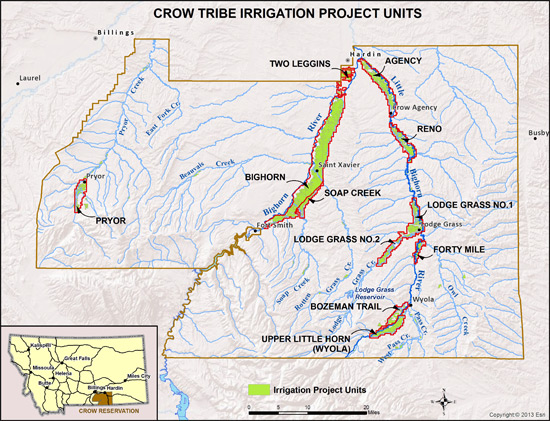
Crow Tribe Irrigation Project Units map
The eleven Units are located entirely in the Pryor, Lower Bighorn, and Little Bighorn Subbasins, along the Bighorn and the Little Bighorn Rivers, Pryor Creek, Lost Creek, Sunday Creek, and Lodge Grass Creek, all of which are tributaries to the Yellowstone River. The general direction of flow within both basins is from southwest to northeast. The primary source of water for the Project originates on tribal lands in the Bighorn Mountains. Essentially all irrigation is supplied by surface water sources.
Across the eleven units, the Project consists of eleven diversion dams, one storage dam with a capacity of about 23,000 acre-feet (Willow Creek Storage Reservoir), approximately 122 miles of main canals, 43 miles of drains, 257 miles of additional canals (e.g., laterals, sub-laterals, and wasteways), and approximately 3,800 irrigation structures (including both BIA and non-BIA owned structures) such as checks, headgates, headworks, flumes, siphons, turnouts, road crossings, spillways, and diversion dams. All current irrigation units are gravity fed and lack any automated flow measurement or gate controls.
In 2006, the Project served approximately 1,118 water users. Current irrigation practices include flood, furrow, wheel-lines, and sprinklers with unlined ditch, lined ditch, and gated pipe as distribution systems. The Crow Irrigation Project serves both Tribal and non-Tribal land owners. The primary irrigated crops are hay and alfalfa, irrigated pasture, sugar beets and grains.
Across the eleven units, during an average irrigation season, the Bighorn, Agency, Reno, Two Leggins, Wyola, and Forty Mile Units generally have sufficient flow via the Bighorn and the Little Bighorn Rivers to meet irrigation demands for the duration of the irrigation season. The Soap Creek, Lodge Grass #1, Lodge Grass #2, Bozeman Trail, and Pryor Creek Units, however, experience irrigation water shortages during average irrigation seasons, with these shortages generally occurring during the months of July, August, and September.
Need for CIP Rehabilitation and Improvement
Currently the Bureau of Indian Affairs manages the CIP and expends funds on operation and maintenance work. Minimal maintenance and construction has occurred on the aging infrastructure since 1940, with a significant portion of the current system in substantial need of rehabilitation. Some facilities of the CIP are beyond their service life and are in poor condition. Other facilities are operating at reduced efficiency or capacity and result in shortages to some lands or are no longer capable of serving lands irrigated in the past. Funding has been a limiting factor to keep up with the needed maintenance and repair work. See the photos below for examples of the current status of the system.
Engineering reports have assessed rehabilitation and improvement needs on CIP units, focusing on key structures and facilities associated with the main canals and laterals. Needs were considered to the extent the irrigation system could be brought back to function as originally designed. Since there is more repair work than funds available, establishing repair priorities will be a key factor for the users.
In addition to infrastructure needs, potential improvements in efficiency have been identified in engineering reports. For example, lack of water flow and reservoir measurement was a key operational deficiency. An automated control system would improve diversions and delivery of water with this added modernization. Along with operations, administrative staffing could be re-organized to improve efficiency and oversight of the project.
In addition to rehabilitation and repairs to existing infrastructure, issues of long-term irrigation water service among tribal and non-tribal members are important considerations for future project priorities. The U.S. Government holds a portion of the irrigated lands in trust for the Crow Tribe and Tribal members. Changes in land uses and ownership on the reservation have occurred over time such that the CIP now serves a larger number of non-tribal farmers compared to tribal farmers. There is a need to implement rehabilitation and improvement work for mutual benefit to the existing users and to address opportunities for future tribal uses. Building effective relationships with the water users is a key need for success of the project.
Opportunities
Several opportunities exist with rehabilitation and improvement of the CIP:
- Improving project productivity while reducing overall water demands by converting flood irrigation to more efficient sprinkler and surge irrigation methods.
- Consolidating service areas to maximize benefits to Indian lands and bringing idle acres back into production.
- Improving water drainage in lands which are currently idled due to excessive water accumulation from irrigation.
- Providing irrigation water to lands formerly irrigated, but currently lacking access to service and to lands where water shortage has led to idle, irrigable lands.
- Increasing benefits to the Tribe or Tribal members through expanding irrigation services to Indian lands in close proximity to project facilities.
Current Status of the System Photos
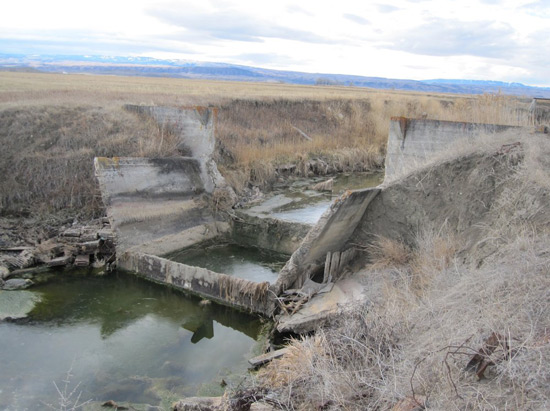
High Check/Drop in Big Horn Irrigation Unit Main Canal: The drop structure shown in the foreground is disintegrating
and is unable to maintain upstream water level, which is causing the check structure immediately upstream to erode.
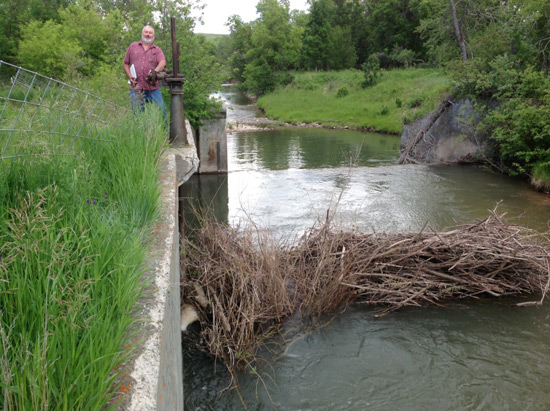
Headgate Blockage on the Willow Creek Feeder Canal: The headgates for the Willow Creek Feeder Canal are substantially blocked
and not properly operable, creating a challenge to maintain the water level in the Lodge Grass Storage Reservoir.
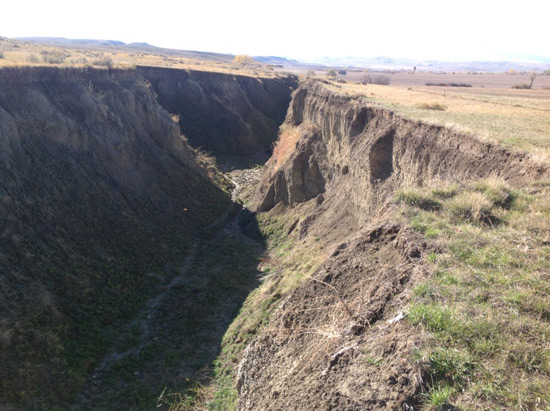
Canal Erosion in Upper Little Horn (Wyola) Irrigation Unit: This canal has had significant erosion due to the failure of a
terminal wasteway structure downstream. The eroding of the canal path (headcutting) will continue up the canal and undermine upstream irrigation
structures.
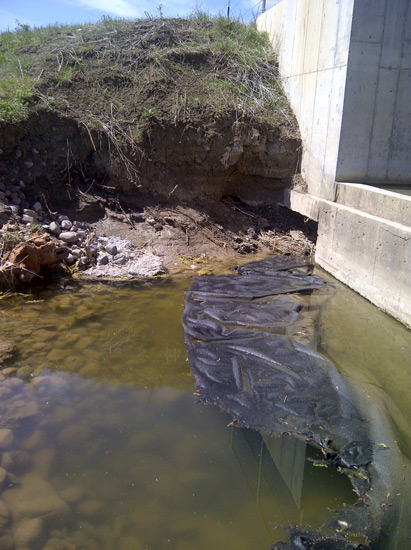
Wasteway Structure Erosion in the Big Horn Irrigation Unit: The erosion around this relatively new structure could compromise
the foundation and integrity of the structure, as well as initiate additional erosion of the streambed downstream of the structure.
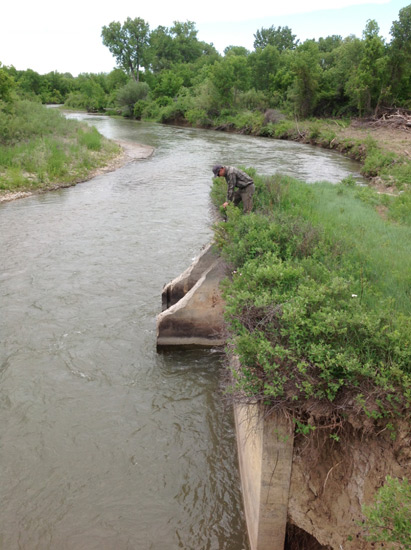
Headworks Erosion and Disrepair in the Forty Mile Irrigation Unit: Riverbank erosion on either side of the headgate structure,
along with disrepair of the concrete and exposed rebar, will eventually render this headworks useless and the river will breach into the canal.
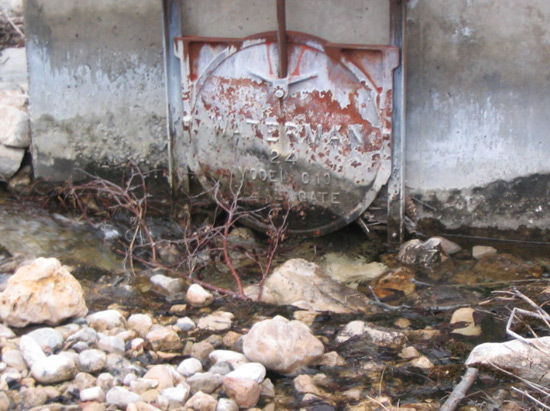
Headgate Flow Restriction in the Pryor Irrigation Unit: The stream flow of Lost Creek has deposited rocks and sediment over the
inlet of the headworks, greatly restricting flow in the irrigation canal.
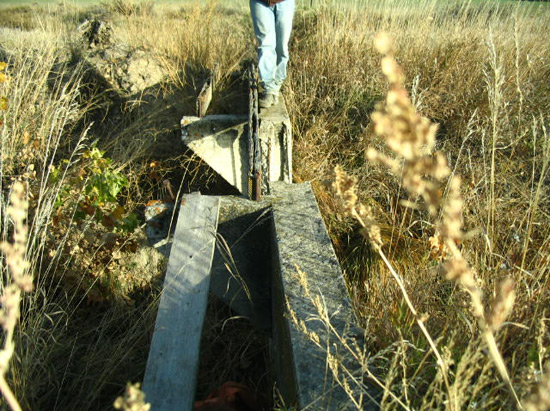
Structure Disrepair on a Lateral Canal: The walkway of this structure is missing due rotted wood planks. Improvised walkways or
lack of walkways create hazard for ditchriders when working around the structure.
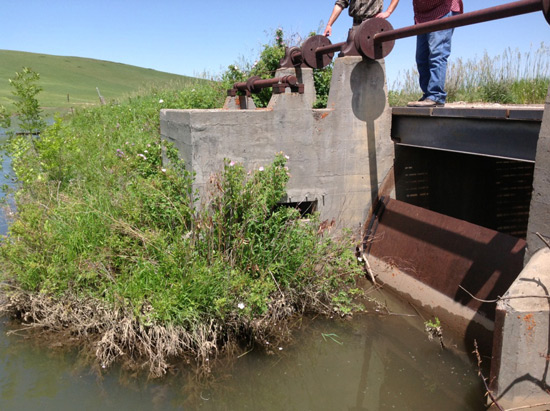
Wasteway Structure on Willow Creek Feeder Canal: This structure was intended to regulate the water level in the canal by spilling
water through the radial gate pictured here. The dysfunctional cable system has made operation difficult, inhibiting control of water delivered to the
Lodge Grass Storage Reservoir and causing buildup of sediment due to improper use.
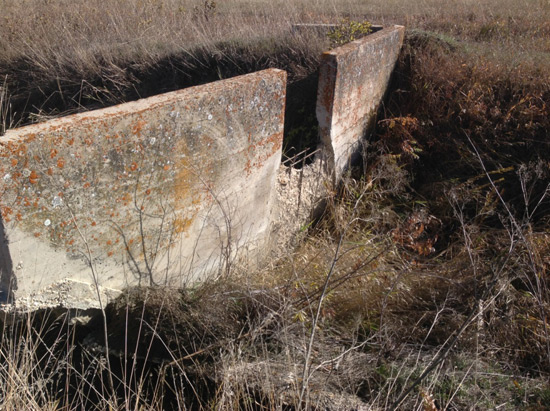
Upper Little Horn (Wyola) Unit Drop Structure Failure: This drop structure has been undermined and is no longer functional.
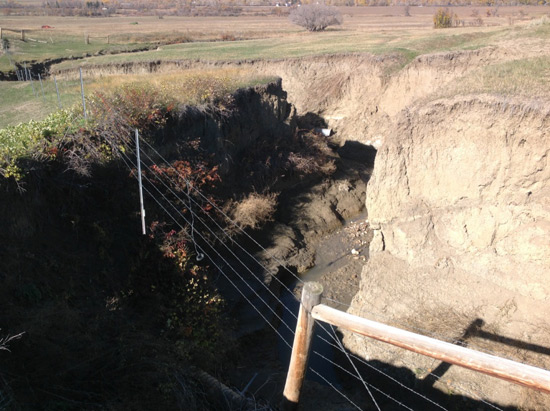
Upper Little Horn (Wyola) Unit Farm Turnout Washout: The washout in this canal occurred at the location where a farm turnout was
once positioned. Currently all excess flows in the canal drain across the farmer's field in the background.
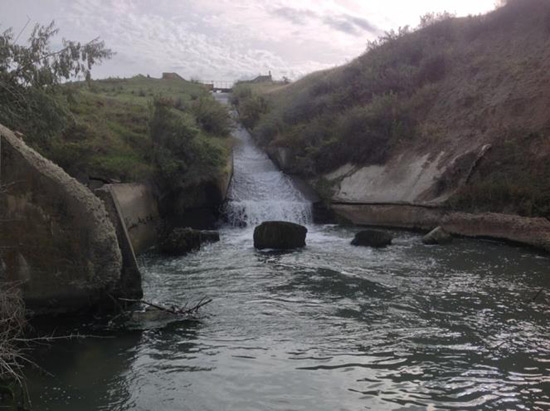
Big Horn Unit Canal Wasteway: The concrete of this wasteway has deteriorated significantly and some of the erosion protection walls
have failed entirely. The integrity of the structure will continue to be compromised with each irrigation season.
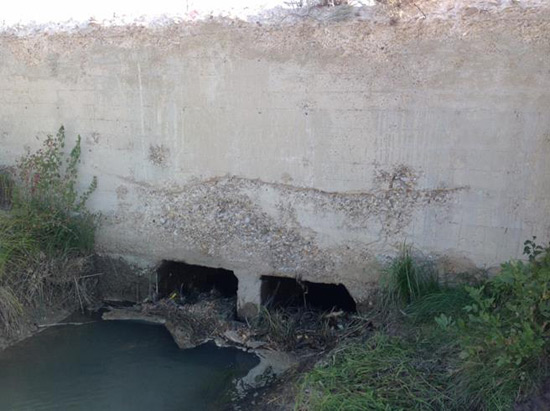
Reno Irrigation Unit Canal Siphon: The siphon concrete has deteriorated significantly, exposing rebar and thus clogging the
conduits and blocking flow in the canal. The structure is beyond repair and will need replacing.

